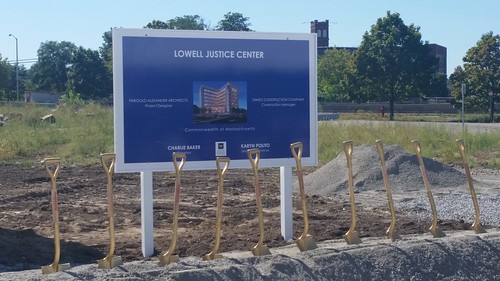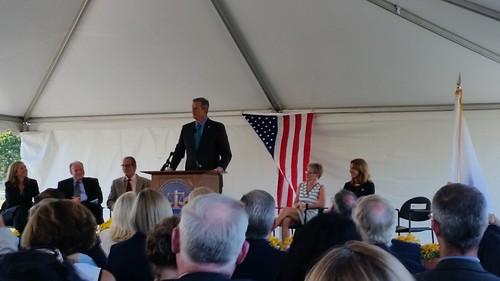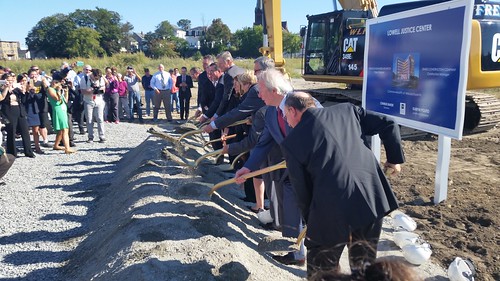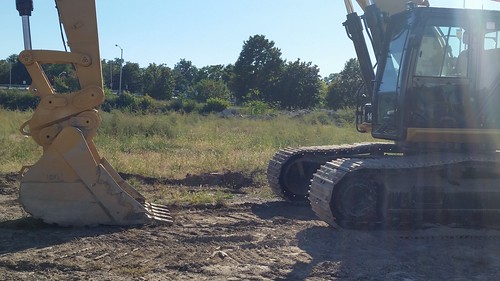Groundbreaking for Lowell Justice Center

More than 200 people gathered under a large white tent on Jackson Street today for the groundbreaking ceremony for the new Lowell Justice Center, formerly known as the Lowell Judicial Center. The event began with the Trial Court Honor Guard posting the colors and the Lowell High School Show Choir singing the National Anthem.
Massachusetts Trial Court Chief Justice Paula Carey welcomed the crowd of state and city officials, lawyers, court personnel, and residents of Lowell. She said the building was to be called the Lowell Justice Center because it was to be focused on the needs of the community. She said that through its function and appearance, it would signify to all who came to it that “justice is the cornerstone of a free society.”
Harry Spence, the Trial Court Administrator, served as the Master of Ceremonies. He said this building will replace others (Lowell District and Superior Courthouses) “that exceeded their useful lives decades ago.” This building will allow justice to be delivered “with dignity and speed.” He said that experience has shown that more cases settle in newer buildings than in old and that size of this building reflects a recognition that the population of Middlesex County, once centered in the southern part, is now equally distributed. He also said that the justice center will be an anchor building for the development of this part of Lowell, just as the Moakley Courthouse was in South Boston.

Gov Charlie Baker
Governor Charlie Baker spoke next. He told a story about how, when he was campaigning in Lowell before being elected governor, he was given a tour of the two courthouses to show him in detail their shortcomings. He quoted Renee Zellweger from “Jerry Maguire” when she said, “You had me at hello.” Baker said he could see immediately that the Lowell courts needed replacement.
Baker then shared another story from when he served as Secretary of Administration and Finance. An unnamed community was supposed to get a new courthouse, but the members of the community could not agree on the location or design of the courthouse. They fought about it for so long that the authorization for the bond that was to pay for it expired and the courthouse was not built (although the community learned its lesson and has since gotten its courthouse). The point of the story, Baker said, was that you need a collection of people in the host community who can work together and “get you to yes” for the benefit of the community. In Lowell, he said, “people know how to work together and get stuff done. He said you never would have gotten to this groundbreaking unless the leaders of Lowell had come together like they did.
Lieutenant Governor Karyn Polito followed Baker and recalled being invited to Lowell by Dave Nangle who “took her for a walk” after breakfast at the Owl Diner. That walk ended at Lowell District Court. Polito repeated the Governor’s line: “You had me at hello.” She also said that as this building is being constructed, state officials will begin work on the disposition of the courthouses that are to be vacated.
Ralph Gants, the Chief Justice of the Supreme Judicial Court spoke next. As a Superior Court judge, he spent countless months at Lowell Superior Court and entertained today’s crowd with some of the “challenges” he faced in conducting trials due to the age of that building. Gants said this new court will “make an enormous difference” and will be a place in which “justice can thrive.”
After current Secretary of Administration and Finance Kristen Lepore spoke, Mr. Spence recognized Maurice Finegold, the lead architect of this project. Spence said two of the most difficult structures to design and build were hospitals and courthouses, and that Mr. Finegold was an expert in courthouse design and that we were all fortunate to have him supervising the design of this project.
Next up were are Lowell legislators. State Senator Eileen Donoghue thanked Governor Baker for following through on his promise to build the Lowell court, a project that has been 15 years in the making. She also acknowledged the important roles played by her predecessor, Steve Panagiotakos, and by Kevin Murphy, our current city manager, during his time as a state representative. (Both Panagiotakos and Murphy were present). Donoghue closed by saying this was “a transformative day for justice, law, and the community.”
State Representative Tom Golden thanked Harry Spence and all who were involved in this project. He said over the 15 year trajectory of this project, there were a lot of people to help. He also said he was tempted to call out some of the naysayers who opposed the court, but he said he would leave it at that. Dave Nangle singled out Panagiotakos and Murphy as key contributors. He specifically thanked Panagiotakos “who hired me as his legislative aide 20 years ago—Steve is the one responsible for me being here today.” Rady Mom, who spoke next, said he was honored to have followed Steve Panagiotakos and Kevin Murphy as the representative of the 18th Middlesex District. He said this groundbreaking symbolized the strength of this community and its importance went beyond the building being constructed.
Mayor Ed Kennedy was the final speaker. He said he likes welcoming the governor and lieutenant governor to Lowell, because they usually bring a big check. He considered the $200 million for this building a very big check. Kennedy next talked about the boost to economic development in the Hamilton Canal District that this building and all those who work and do business in in will bring. He then recalled gathering just across the Hamilton Canal on the evening of September 1, 2016, for the Lowell Vitality Project’s lighting demonstration on Swamp Locks. He believes that between the new court and the lighting of the adjacent canals, this will be one of the most vibrant locations in the city. Kennedy closed by making a strong case that the Lowell Judicial Center should be named for the late Cornelius Kiernan, a lifelong resident of Lowell who was a leader in the state legislature, a lawyer, and a judge of the Lowell District Court. Kiernan, Kennedy said, “was very deserving and has been long overlooked.”

With that, the dignitaries moved to a nearby pile of gravel, dug in their gold-colored shovels, and broke ground. If all goes well, they will return in 30 months for the ribbon cutting.

Courthouse construction site
The new Judicial Center construction site is on several of my regular walks in the city. It will be interesting to see how the site changes over the next three years.
Does anyone know if a public art/sculpture is in the plans?
Richard, thanks for all that you do for city.